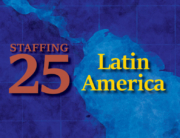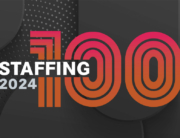In 2020, the killings of George Floyd, Breonna Taylor and Ahmaud Arbery as well as a surge of unprovoked attacks on Asian Americans revealed a dark aspect of American life and galvanized millions to demand change.
Staffing providers, too, were urged to confront inequities in their policies and their organizations. The industry stepped up. Firms added diversity experts to their executive teams, altered strategies to source talent from underserved communities, developed processes to eliminate bias in candidate screening and more.
But then the political climate shifted and the economy slowed. Now, interest in DE&I programs across the country is waning, with significant consequences to companies and the people they serve.
According to employment data provider Live Data Technologies, 35% of professionals who started in DE&I roles across a range of industries in 2020 had left the field by the end of 2023.
Chief diversity officers also experienced higher turnover; 40% more CDOs left their role compared to their CHRO counterparts in the first half of 2023, according to Live Data Technologies.
“There is undoubtedly a sense of ‘diversity fatigue,’” SIA Research Analyst Francesca Profeta writes in her DE&I Trends in Staffing 2024 report. Companies that pledged billions to DE&I programs are now pulling back, according to the report.
Political Scrutiny
The changing US political landscape has also undermined such initiatives.
When the US Supreme Court struck down affirmative action for college admissions programs in 2023, companies began bracing for potential legal challenges. The impact on staffing firms has been chilling.
In January 2024, Sen. Tom Cotton, R-Arkansas, sent letters to the top executives at 10 of the largest US staffing firms warning that complying with diversity, equity and inclusion mandates may violate federal law because they might be excluding “non-diverse” candidates. Cotton alludes to “troubling reports” that staffing firms are conspiring with other companies to exclude “non-diverse” candidates.
Staffing leaders are not advancing DE&I programs as much as they could be, according to SIA’s report Proving the Diversity Business Case for the Recruitment and Staffing Industry. Only 23% of board members “influence” these initiatives, the report shows, leaving it up to employees and clients to drive DE&I adoption.
Economic Travails
DE&I initiatives have also been crimped by economic worries. With inflationary pressure still weighing, attention has shifted toward cutting costs, according to SIA’s DE&I Trends in Staffing 2024 report.
“Business leaders have navigated a disruptive period in recent years, with many diverted by ’established’ risks — such as inflation, cost-of-living crises, trade wars, capital outflows from emerging markets, widespread social unrest, geopolitical confrontation and low economic growth, including recession in some countries,” Profeta writes. “Therefore, it is unsurprising that DE&I has not been as prominent an issue as it was post-pandemic.”
A ‘Mixed Bag’
Now some staffing firms are uncertain about how to proceed, explains Keilon Ratliff, chief diversity officer at Kelly.
“Some of them are at a pause, or kind of a wait-and-see because of the political landscape,” Ratliff says. “Some of them — through some fatigue and maybe some inefficient strategies — have kind of veered away.” But then, he adds, “You see some that are doubling, tripling down. It’s a bit of a mixed bag right now.”
DeLibra Wesley, founder and CEO of National Recruiting Consultants and a sought-after expert on DE&I in the staffing industry, sees any pullback as both a lost opportunity and the consequence of not proving DE&I initiatives’ value.
“We had a great window of opportunity in 2020 to make a huge impact,” Wesley says, but “… we did not do an excellent job on executing and proving out how well it can work if we diversify our teams.”
Focus on the ‘Doing’
Now it’s time to double down, DE&I experts say.
For her part, Wesley says she’s focused on taking specific actions.
“We did a lot of training and not a lot of doing. We talked about what we needed to do, but no one really did it,” she says.
Wesley has noticed that people who attend her speaker panels or reach out for advice are generally those who already advocate for diversity in their organizations. However, the leaders who need the insights are not showing up, she says.
To counteract that, National Recruiting Consultants has bolstered its DE&I programs. It donates monthly to diverse organizations that affect the staffing ecosystem or the special education sector the company serves. In addition, Wesley launched Women of Color in Staffing, a nonprofit program that provides mentorship and networking opportunities as well as a diversity job board.
In another example of firms trying to make a difference, Primary Talent Partners holds companies accountable for earlier promises by pulling their published diversity reports and comparing them with leaderships’ current commitments.
“You have to constantly remind them,” Douglas says. “Is this still a priority? I think it’s a constant education, constantly pushing it and never [stopping].”
Here are other ways companies in the staffing ecosystem can boost DE&I:
Explore partnerships. By partnering with diverse organizations, community programs, Historically Black Colleges and Universities and other representative groups, companies can find, develop and nurture talent.
Primary Talent Partners, for example, has nearly quadrupled its spend in its PrimaryPathways program, which provides paid internships to HBCU students to develop business skills, explore career paths and build professional networks.
Diversify internal staff. Research suggests that firms that actively diversify their internal employee cohort may perform better than their competitors. Having a diverse workforce leads to more innovative ideas and delivering better products and services more quickly, according to McKinsey research from 2023. Companies in the top quartile for ethnic diversity were 39% more likely to outperform than those in the bottom quartile. Businesses employing more than 30% women at the executive level are significantly more likely to financially outperform those with fewer than 30%.
Invest in analytics. Clients want their workforces to be diverse; they just lack the data to show what they have. Staffing firms that can verify the diversity of their talent pools are at a competitive advantage when pursuing buyer clients, explains Catie Brand, global head of talent and operations at General Assembly.
“To champion investment and programs, they need to have more data. So, any way they can promote the collection of that data will be really valuable,” Brand says.
Form inclusion groups. Employee resource groups can provide community for diverse staff members. Don’t forget to include senior leadership.
Kelly’s newly established Executive Inclusion Council includes CEO Peter Quigley, along with his direct reports and representatives from every business unit, keeping DE&I at the forefront of company initiatives.
Getting Back on Track
The staffing industry is on a precipice and needs to make hard choices. Is DE&I a priority, or is it not?
Kelly’s Ratliff looks at diversity as a “humanity play.”
“When you focus on the word ‘diversity,’ sometimes that’s what causes the arguments,” he says. It can lead to heated debates and animosity among colleagues and leadership teams. “But when we talk about humanity, diversity is for everyone.”







